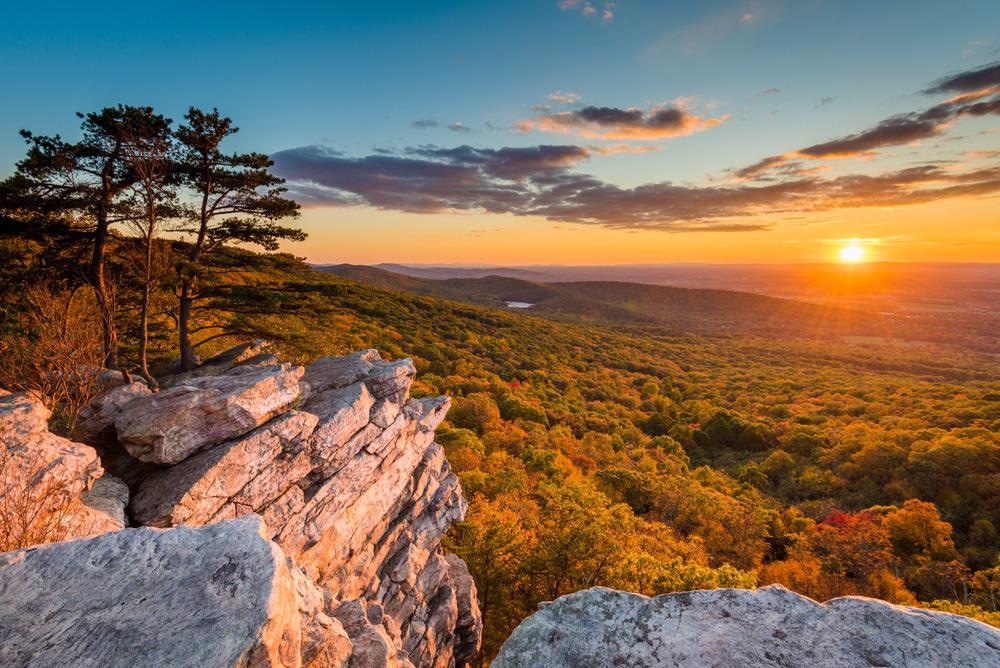The coal industry has had a negative effect on the Appalachian region of the US. It has disrupted local ecosystems, tearing away around 400,000 hectares of carbon-capturing forests. It also desolated whole communities when mining jobs abruptly vanished as dwindling coal resources made mines unprofitable. Green Forests Work is a clean technology company seeking to heal the Appalachian region with massive, earth-moving, tree-planting projects.

Image Credit: Jon Bilous/Shutterstock.com
Green Forests Work, in partnership with numerous partners as well as the federal U.S. Forest Service, is returning forests to the famous Appalachian hills, including on a 1000-hectare tract of the Monongahela Forest that was strip-mined in the 1980s.
Converting Coal Mines to Carbon Sinks
Green Forests Work restores the damage caused by coal mining in more ways than one.
Carbon dioxide (CO2) emissions from burning fossil fuels such as coal for energy have dramatically increased the rate of global warming since the Industrial Revolution started in Britain in the 18th century.
Now, with climate crises on the horizon and the consensus of environmental scientists warning that huge changes in our economy and society are required to avoid the worst-case scenario outcomes of climate change – drought, extreme weather events such as floods and hurricanes, water shortages, and mass extinctions.
Simply reducing the amount of CO2 we emit by burning fossil fuels is not enough, although it is absolutely necessary.
Now, scientists are urging world leaders to ramp up carbon capture and sequestration. Carbon capture – taking CO2 out of the atmosphere or water – can be achieved with expensive and complex technology. Carbon sequestration – storing CO2 in a stable form so that it will not re-enter the atmosphere for up to 1000 years – can also now be achieved with industrial machinery.
But there is an even simpler – and much more effective – means of taking CO2 out of the air and keeping it out of the air. It does not require any complex machinery or tools, and it is a well-established and understood process. It is called photosynthesis.
Rewilding is the process of removing any human-made impediments to the natural growth of ecosystems in places that humans have made uninhabitable for our plant and animal neighbors, and then letting nature take over.
Green Forests Work is undertaking large-scale rewilding projects in the Appalachian hills to restore natural carbon sinks – large forests – to the area. Since 2009, the company has planted almost 4 million trees across over 6,000 acres in the region.
Ripping Up the Earth: Rewilding with a Bulldozer
Strip mines in the Appalachian region were closed down from the 1990s when coal stocks were too depleted for mines to remain profitable. At the time, it was considered best practice to restore these mines with closely packed rock and shallow-rooting grass.
This ensured that the upheaved earth over the mines and mountain tops would stay in place, preventing erosion to maintain the hills’ structural integrity. But, other than grass with shallow roots, plants would not grow in these environments as water could not infiltrate the closely packed rock, roots could not penetrate through, and oxygen could not circulate in the stifled air.
Green Forests Work takes an unconventional approach to this problem. The company sends in heavy-duty machinery to rip up the compacted ground, scoring deep grooves into the earth below that trees can take root in.
A pilot 30-hectare trial in Monongahela began in 2011, with bulldozer-like machines sent to a former strip mine site to dig up the ground. Local forest rangers had unsuccessfully tried for years to get trees to grow on the site. Ten years on, the trees planted in the site are flourishing.
Restoring Economies and Ecosystems
The method developed by Green Forests Work costs approximately $5,000 per hectare to commit the machine- and human-power needed to restore forests to Appalachia’s former strip mines.
But, as well as producing environmental benefits, this work reinvigorates the local economy, which was left devastated when mining left former coal-field states en masse from the 1990s.
Heavy equipment suppliers and operators, seed collectors, local nurseries, and the local service industry all benefit from the funding and investment that Green Forests Work brings to the area. The Monongahela project alone has poured approximately $1 million to the local economy.
Carbon Capture with Forests
Tree planting and forest management are among the most cost-effective, scalable strategies for carbon capture available to us today. A third of the greenhouse gas reductions needed to avoid the worst possible climate disasters could be captured and stored with properly maintained and restored forests.
Until recently, the role of forests and other natural climate solutions have been poorly understood. But recent research found that natural climate solutions can take 23.8 petagrams of CO2 out of the atmosphere, more than 30% higher than previous estimates.
These solutions can provide 37% of the CO2 mitigation to 2030 that scientists say would provide a 66% or higher chance of keeping global warming below 2 °C. Scientists say that a third of this could come from relatively cheap projects, at or below $10 per Mg of CO2-1.
These kinds of projects also benefit the environment in other ways. Walter filtration, flood resistance, improved soil health, biodiversity, and enhanced climate resilience are all provided in restored forests.
References and Further Reading
Baragona, S. (2018). Former West Virginia Coal Mines Turned into Carbon-sucking Forests. VOA News. Available at: https://www.voanews.com/a/former-west-virginia-coal-mines-turned-into-carbon-sucking-forests/4657161.html.
Griscom, B.W. et al. (2017). Natural climate solutions. PNAS. Available at: https://doi.org/10.1073/pnas.1710465114.
Popkin, G. (2020). The Green Miles. Washington Post. Available at: https://www.washingtonpost.com/graphics/2020/lifestyle/magazine/appalachia-kentucky-reforestation/?fbclid=IwAR1dRQXX3T_uKyqmh0zd8BtlpaDNuRih-dAT-leA2yE1JqyAd0Wet_M96ss.
Disclaimer: The views expressed here are those of the author expressed in their private capacity and do not necessarily represent the views of AZoM.com Limited T/A AZoNetwork the owner and operator of this website. This disclaimer forms part of the Terms and conditions of use of this website.